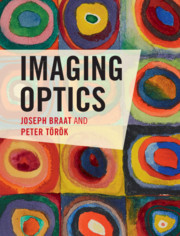Description
Imaging Optics
Authors: Braat Joseph, Török Peter
This comprehensive and self-contained text for researchers and professionals presents a detailed account of optical imaging from the viewpoint of both ray and wave optics.
Language: English
Approximative price 75.14 €
In Print (Delivery period: 14 days).
Add to cart
Publication date: 05-2019
984 p. · 19.2x25.4 cm · Hardback
984 p. · 19.2x25.4 cm · Hardback
Description
/li>Contents
/li>Biography
/li>
This comprehensive and self-contained text presents the fundamentals of optical imaging from the viewpoint of both ray and wave optics, within a single volume. Comprising three distinct parts, it opens with an introduction to electromagnetic theory, including electromagnetic diffraction problems and how they can be solved with the aid of standard numerical methods such as RCWA or FDTD. The second part is devoted to the basic theory of geometrical optics and the study of optical aberrations inherent in imaging systems, including large-scale telescopes and high-resolution projection lenses. A detailed overview of state-of-the-art optical system design provides readers with the necessary tools to successfully use commercial optical design software. The final part explores diffraction theory and concludes with vectorial wave propagation, image formation and image detection in high-aperture imaging systems. The wide-ranging perspective of this important book provides researchers and professionals with a comprehensive and rigorous treatise on the theoretical and applied aspects of optical imaging.
Preface; Acknowledgement; Part I. Electromagnetic Theory in the Optical Domain: 1. Electromagnetic wave propagation in isotropic media; 2. Wave propagation in anisotropic media; 3. Surface waves, metamaterials and perfect imaging; Part II. Geometrical Theory of Optical Imaging: 4. Foundations of geometrical optics; 5. Aberration analysis of optical systems; 6. Analytic design and optimisation of optical systems; 7. Design methods for optical imaging systems; Part III. Diffraction Theory of Optical Imaging: 8. Vectorial and scalar theory of diffraction and focussing; 9. The aberrated scalar and vector point-spread function; 10. Frequency analysis of optical imaging; 11. Theory of vector imaging; Appendix A. Fourier analysis, complex notation and vector formulas; Appendix B. Phase and group velocity of a wave packet; Appendix C. The Kramers-Kronig dispersion relations; Appendix D. Zernike polynomials; Appendix E. Magnetically induced optical rotation (Faraday effect); Appendix F. Vector point-spread function in a multilayer structure; Appendix G. V. S Ignatowsky: diffraction by a lens of arbitrary aperture; References; Author index; Subject index.
Joseph Braat is Emeritus Professor of Optics at Technische Universiteit Delft, The Netherlands, and a Fellow of the Dutch Royal Academy of Arts and Sciences. Previously he was based at the Philips Research Laboratories in Eindhoven where he worked on optical disc systems for video and audio recording and on high-resolution optical lithography. He was Co-Founder of the European Optical Society and his further research interests are diffraction theory, astronomical imaging and optical metrology.
Peter Török is Professor of Optical Physics at the Nanyang Technological University, Singapore and at Imperial College of Science, Technology and Medicine, London. His research is focused on the theory of diffraction, focusing and microscopy, with particular emphasis on confocal microscopy, spectroscopic imaging and polarisation. Throughout the years he has taught vector calculus, electromagnetism, optical imaging, and optical design theory.
Peter Török is Professor of Optical Physics at the Nanyang Technological University, Singapore and at Imperial College of Science, Technology and Medicine, London. His research is focused on the theory of diffraction, focusing and microscopy, with particular emphasis on confocal microscopy, spectroscopic imaging and polarisation. Throughout the years he has taught vector calculus, electromagnetism, optical imaging, and optical design theory.
© 2024 LAVOISIER S.A.S.
These books may interest you

Introduction to Lens Design 71.34 €



